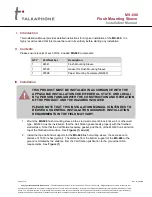
Installation Instructions
Page 1 of 28
© 2019 CommScope, Inc. All Rights Reserved
TENIO
TC-1251-2-IP
Rev C, January 2019
www.commscope.com
1.
About this installation instructions
The TENIO fiber enclosure is a modular enclosure that is composed of different building blocks to meet the specific client
needs. This installation instruction provides an overview of the building blocks and their variants and how they fit together.
Environmental conditions in which the enclosure can be used are described in this document as well as product dimensions
and capacity (splice capacity, cable diameter range, and cable types).
In addition this instruction will explain:
- how to prepare the enclosure, feeder cable, and drop cables;
- how to install cables in the enclosure (including use of the CTU);
- how to route fibers to the splice and/or patch trays or to the POC storage area;
- how to install fibers on the trays;
- how to close and properly seal the enclosure;
- how to mount the enclosure with the mounting bracket; and
- how to use the external cable fixation bracket.
This instruction also includes a section describing re-entry to the enclosure after installation for adding a new cable or for
accessing the fiber management system.
2.
Warnings and caution
2.1.
Fiber optic cables may be damaged if bent or curved
to a radius that is less than the recommended minimum bend
radius. Always observe the recommended bend radius limit when
installing fiber optic cables and patch cords.
2.2.
Exposure to laser radiation can seriously damage the
retina of the eye. Do not look into the ends of any optical
fiber. Do not assume the laser power is turned off or
that the fiber is disconnected at the other end.
3.
List of acronyms and abbreviations
POC
Passive Optical Components
CTU
Cable Termination Unit
SKG
Sealing Kit Gel
SLE
SLim Element (tray)
FAS
Fiber Arrangement System


































